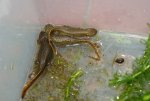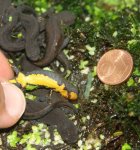I keep Cynops fudingensis and C. orphicus for some years and breed both now.
I was lucky to get wc specimens with locality data from a friend.
In C.orphicus this year I had the first larvae. I rescued some eggs from the "cannibalistic parents".
There is a habit in fudingensis breeders should pay attention to:
metamorphed juvies of fudingensis avoid the water and will starve to death but not go underwater to feed. After 1 or 2 years in autumn with rising temperatures the first youngsters entered the water again. Out of 100 metamorphs only one stayed in water from the beginning and grew very quick. I raise them in plastic boxes with 15cm water level and lots of plants and a cork island with moss and hiding bark on top. if the water is full of duck weed not so many feeder insects will drown. I feed micro crickets and Drosophila hylei, dusted regularly with mineral/vitamine powder.
snails in the water clean the water if some crickets fell in.
My guess, in orphicus it will be similiar regarding land phase. I will let you know soon.
pics of parents fudingensis, pay attention to the variability; and larvae on their "island" ,bark flipped.
I was lucky to get wc specimens with locality data from a friend.
In C.orphicus this year I had the first larvae. I rescued some eggs from the "cannibalistic parents".
There is a habit in fudingensis breeders should pay attention to:
metamorphed juvies of fudingensis avoid the water and will starve to death but not go underwater to feed. After 1 or 2 years in autumn with rising temperatures the first youngsters entered the water again. Out of 100 metamorphs only one stayed in water from the beginning and grew very quick. I raise them in plastic boxes with 15cm water level and lots of plants and a cork island with moss and hiding bark on top. if the water is full of duck weed not so many feeder insects will drown. I feed micro crickets and Drosophila hylei, dusted regularly with mineral/vitamine powder.
snails in the water clean the water if some crickets fell in.
My guess, in orphicus it will be similiar regarding land phase. I will let you know soon.
pics of parents fudingensis, pay attention to the variability; and larvae on their "island" ,bark flipped.



